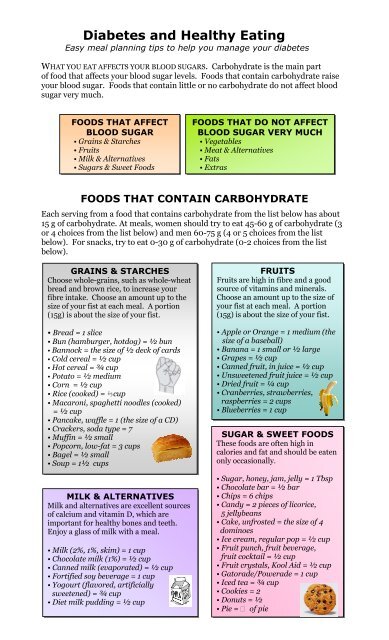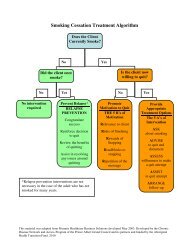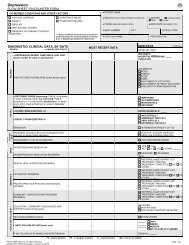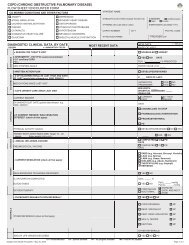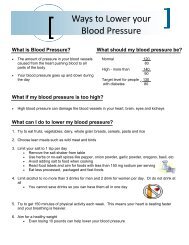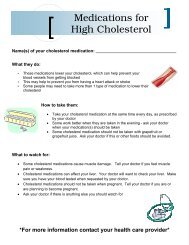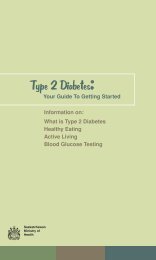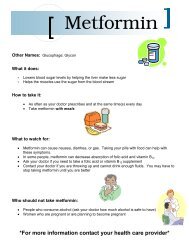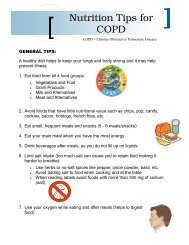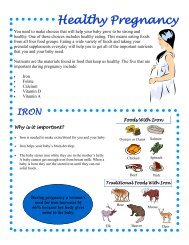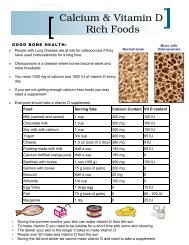Diabetes and Healthy Eating - Chronic Disease Network & Access ...
Diabetes and Healthy Eating - Chronic Disease Network & Access ...
Diabetes and Healthy Eating - Chronic Disease Network & Access ...
Create successful ePaper yourself
Turn your PDF publications into a flip-book with our unique Google optimized e-Paper software.
<strong>Diabetes</strong> <strong>and</strong> <strong>Healthy</strong> <strong>Eating</strong>Easy meal planning tips to help you manage your diabetesWHAT YOU EAT AFFECTS YOUR BLOOD SUGARS. Carbohydrate is the main partof food that affects your blood sugar levels. Foods that contain carbohydrate raiseyour blood sugar. Foods that contain little or no carbohydrate do not affect bloodsugar very much.FOODS THAT AFFECTBLOOD SUGAR• Grains & Starches• Fruits• Milk & Alternatives• Sugars & Sweet FoodsFOODS THAT DO NOT AFFECTBLOOD SUGAR VERY MUCH• Vegetables• Meat & Alternatives• Fats• ExtrasFOODS THAT CONTAIN CARBOHYDRATEEach serving from a food that contains carbohydrate from the list below has about15 g of carbohydrate. At meals, women should try to eat 45-60 g of carbohydrate (3or 4 choices from the list below) <strong>and</strong> men 60-75 g (4 or 5 choices from the listbelow). For snacks, try to eat 0-30 g of carbohydrate (0-2 choices from the listbelow).GRAINS & STARCHESChoose whole-grains, such as whole-wheatbread <strong>and</strong> brown rice, to increase yourfibre intake. Choose an amount up to thesize of your fist at each meal. A portion(15g) is about the size of your fist.• Bread = 1 slice• Bun (hamburger, hotdog) = ½ bun• Bannock = the size of ½ deck of cards• Cold cereal = ½ cup• Hot cereal = ¾ cup• Potato = ½ medium• Corn = ½ cup• Rice (cooked) = ⅓ cup• Macaroni, spaghetti noodles (cooked)= ½ cup• Pancake, waffle = 1 (the size of a CD)• Crackers, soda type = 7• Muffin = ½ small• Popcorn, low-fat = 3 cups• Bagel = ½ small• Soup = 1½ cupsMILK & ALTERNATIVESMilk <strong>and</strong> alternatives are excellent sourcesof calcium <strong>and</strong> vitamin D, which areimportant for healthy bones <strong>and</strong> teeth.Enjoy a glass of milk with a meal.• Milk (2%, 1%, skim) = 1 cup• Chocolate milk (1%) = ½ cup• Canned milk (evaporated) = ½ cup• Fortified soy beverage = 1 cup• Yogourt (flavored, artificiallysweetened) = ¾ cup• Diet milk pudding = ½ cupFRUITSFruits are high in fibre <strong>and</strong> a goodsource of vitamins <strong>and</strong> minerals.Choose an amount up to the size ofyour fist at each meal. A portion(15g) is about the size of your fist.• Apple or Orange = 1 medium (thesize of a baseball)• Banana = 1 small or ½ large• Grapes = ½ cup• Canned fruit, in juice = ½ cup• Unsweetened fruit juice = ½ cup• Dried fruit = ¼ cup• Cranberries, strawberries,raspberries = 2 cups• Blueberries = 1 cupSUGAR & SWEET FOODSThese foods are often high incalories <strong>and</strong> fat <strong>and</strong> should be eatenonly occasionally.• Sugar, honey, jam, jelly = 1 Tbsp• Chocolate bar = ½ bar• Chips = 6 chips• C<strong>and</strong>y = 2 pieces of licorice,5 jellybeans• Cake, unfrosted = the size of 4dominoes• Ice cream, regular pop = ½ cup• Fruit punch, fruit beverage,fruit cocktail = ½ cup• Fruit crystals, Kool Aid = ½ cup• Gatorade/Powerade = 1 cup• Iced tea = ¾ cup• Cookies = 2• Donuts = ½• Pie = of pie
FOODS THAT CONTAIN LITTLE OR NOCARBOHYDRATEVEGETABLESFresh, frozen, or canned, vegetables arelow in carbohydrate, calories, <strong>and</strong> fat. Eatvegetables freely throughout the day.Choose as much as you can hold in bothh<strong>and</strong>s at each meal.• Broccoli• Carrots• Celery• Cucumber• Lettuce (salad)• Beans, green or yellow• Tomato• Peas• Cabbage• Onions• Frozen vegetables• Canned vegetablesMEAT & ALTERNATIVESFoods in this group are excellentsources of protein. Choose anamount the size of your palm <strong>and</strong>the thickness of your little finger.• Low fat Cheese (


